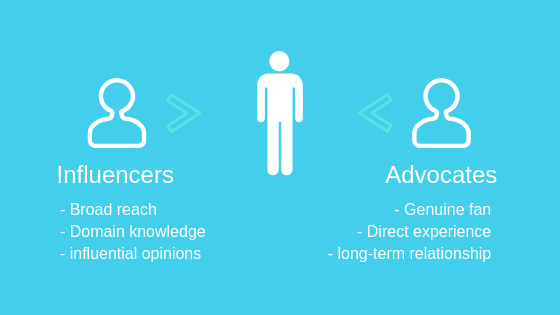How to Start with Nonprofit Influencer Marketing
Want to make good use of the power of influencer marketing to promote your nonprofit, charity or social enterprise? Check out how you can get started effectively.

For this post, I wanted to put the focus on how an overarching marketing concept such as influencer marketing can have a positive impact on non-profits.
We have a better understanding now of how social media, content marketing and email marketing can help a non-profit organization exceed fundraising goals, raise event attendance and even recruit scores of new volunteers, but what about influencer marketing? How does influencer marketing fit in the larger picture on marketing strategy for non-profits?
As it turns out, the concept of influencer marketing may not be as foreign as you think. You may have potential influencers in your audience-dedicated fans who have been donating to your fundraising campaigns, volunteering at your events and sharing any and all organization news. In marketing, we call these individuals brand advocates.
Brand advocates are passionate people who believe in what your brand represents and the message behind it. They’re the ones who are sharing updates via social media, encouraging others to donate and attending and volunteering at your events. Brand advocates champion your cause-and they’re also spreading the word with new audiences every day.

So what’s the difference between a brand advocate and an influencer and how do you turn a brand advocate into one? A brand advocate will champion your cause for free-and they may or may not have a large audience. An influencer, whether they’re high-profile or micro, has a dedicated, highly engaged audience who trusts their recommendations. An influencer promotes your cause after entering into a partnership with your organization. With a specific set of criteria, any brand advocate can become an influencer.
Learn more about the types of influencers and how you can form partnerships with them.
First this: Grow faster than ever before!
Seamlessly blend creativity and technology. See how you can start with AI Marketing and reach your goals faster than ever before. Check out the Tips, Strategies, AI Tools, Masterclass, Courses, and Community. Unleash the true potential of your brand with the help of AI.
In this article
Identify Your Nonprofit’s Social Media Marketing Strategy
Before you start setting up your campaigns and partnering with Influencers, make sure you’ve set up your Nonprofit’s social media marketing strategy.
At GlobalOwls, we believe that Nonprofits and Social Enterprises are the true heroes of our society and that Nonprofit Marketers are the ones that fight every day to make the world a better place with too little time, money, and resources.
Our mission is to help them to become more effective with those limited resources.
Check out our book on how Nonprofits can get more out of their Social Media Marketing efforts.
We see that some Nonprofits are crushing it on social and many others… don’t.
By following the tips and strategies that are laid out in this book, everyone should be able to achieve their goals faster.
The book goes into specific use cases for nonprofits to become more effective at Social Media Marketing. If you don’t have the time to check out the book, check out this short video that can also help you create your Social Media Marketing Strategy effectively. Be mindful that you might be mission out on some essential nonprofit tactics.
Being specific about your influencer strategy will help you find the right people to work with. Defining what your objective is will drive the influencer search, the type of content the influencers will be posting and social media themes.
Ultimately, influencer marketing aims to build an emotional connection between a non-profit organization and the target audiences, through experiences. Here are some of the content strategies you should be considering to help engage audiences:
Awareness Campaign
Work with influencers to create/share inspirational content that shows the audience why your mission & programs are important to them (ie. showing women getting back into the workforce with your programs that assist women in poorer countries with building their own businesses).
Interest Campaign
Work with influencers to create/share educational content with their networks on how to use your program & build skills.
Decision Campaign
Influencers share stories from your organization about the people you have helped and how they’ve benefitted.
Action Campaign
Influencers can share promotional content that lets audiences know where they can donate, sign up to volunteer and/or attend the event
After you decide on what your objective will be, it’s time to identify the influencers your non-profit should be working with.
Finding the Right Influencers to Work With

Enlisting influencers can help increase the legitimacy of your cause among the public by spreading your name through a trusted source and can be a great way to gain new audiences, potential donors and volunteers. Working with influencers who have press experience and highly engaged audiences may also increase the chances of your cause getting press coverage and increase engagement.
When you’re looking to work with influencers, keep in mind that there are three main types of influencers: top-tier, power middle and micro.
Top Tier Influencers
Typically public figures with extremely high reach, with anywhere between 750k-1M+ fans across all platforms. They’re notable, well-known and have built their highly engaged audiences over years. Influencers in this category don’t normally work for free and have experience working with bigger brands.
Power Middle Influencers
They usually have a moderate reach of between 50K-250K followers across social media. They’re more likely to have agreeable cost agreements or perhaps none at all as they’re still building their audience & brand.
Micro-Influencers (Also known as Long-Tail Influencers)
These influencers have a relatively low reach, less than 10K across social media. They do, however, have highly engaged audiences and their accessibility and reliability resonate with consumers.
How to Find the Right Influencers
Remember what I mentioned earlier, about how you might already have potential influencers in the form of brand advocates who are championing your cause? Look through your organization’s Facebook, Twitter, Instagram and even YouTube fans and followers for detailed analytics. Take a note of the accounts that have been commenting on your status updates, sharing your fundraising campaigns and signing up to attend your events more often as these people could be potential influencers.
Outside of your own social media accounts, you should also be looking through Instagram and Twitter hashtags related to your cause. If you find a potential influencer, you should follow them and use the Suggestion feature to find accounts with similar content. Detailed, Google searches can also help you find potential influencers.
Your email subscriber database would also be a good place to start because people who signed up for your newsletter are already invested in your cause and would be more likely to share content for you.
Don’t assume that bigger is better when looking for influencers. Often, going after big-name celebrity or digital influencers with huge fanbases don’t provide the best ROI. In fact, working with micro long-tail influencers may provide higher conversion rates because they’re generally more engaged with their audiences. The process to find micro-influencers for your brand is not very different from macro-influencers, but your chances of getting noticed are three times higher with micro-influencers as they tend not to get so much attention from big brands. And this is where the opportunity lies; as mentioned, micro-influencers are more authentic, engaged, and loyal to their followers!
No matter who you choose to work with as an influencer, remember these vital tips:
BEFORE presenting them with the offer, make sure to interact with them.
Follow their accounts on different platforms, share and comment on their content and just interact with them on social media in general. Before asking them to do something for you, you need to spend some time and energy building a relationship with key influencers.
When you do present them with an offer, BE CLEAR on what you want.
When you present influencers with an offer, make it clear on what you need from them (Facebook posts, Instagram posts, videos etc.) and how often you need them to post. Then you need to be clear on what they can expect in return, whether it’s financial compensation or something else.
Be strategic and choose quality over quantity.
As I mentioned earlier in the post, make sure you define what your campaign goals are and try and engage the influencers you want to work with in early discussions on how the partnership could work. Whether it’s your first influencer campaign or your 20th, make sure to keep your influencer group small and tailor your program to each influencer. Not only is it more manageable time-wise for your organization, influencers like to feel valued and expect to be treated as individuals. So it’s important to not spread yourself too thin and give your organization time to nurture these key relationships.
FAQ
What Is Nonprofit Influencer Marketing?
Nonprofit influencer marketing involves partnering with influential individuals on social media or other platforms to promote a nonprofit’s cause, campaigns, or events to a broader or more targeted audience.
Why Is Influencer Marketing Important for Nonprofits?
Influencer marketing is important for nonprofits as it can significantly extend their reach, enhance credibility, and tap into new donor and volunteer bases through the influencers’ followers.
How Can Nonprofits Identify the Right Influencers for Their Campaigns?
Nonprofits can identify suitable influencers by looking for individuals whose values align with their mission, have an engaged and relevant audience, and demonstrate a genuine interest in social causes.
What Are the Benefits of Nonprofit Influencer Marketing?
Benefits include increased awareness of the cause, higher engagement rates, potential growth in donations and volunteer sign-ups, and the ability to reach specific demographics or niche audiences.
How Should Nonprofits Approach Influencers for Collaboration?
Nonprofits should approach influencers with a clear, concise pitch that outlines the mission, the goals of the collaboration, and how it aligns with the influencer’s interests and audience.
What Types of Content Work Best for Nonprofit Influencer Marketing?
Effective content types include personal stories related to the cause, behind-the-scenes looks at nonprofit activities, testimonials, event promotions, and calls-to-action for donations or volunteerism.
Can Nonprofit Influencer Marketing Be Measured for Effectiveness?
Yes, the effectiveness can be measured through metrics such as reach, engagement rates, website traffic referrals, and tracking any increases in donations or volunteer registrations attributable to the campaign.
What Are the Challenges of Nonprofit Influencer Marketing?
Challenges include finding the right influencer fit, managing collaborations within budget constraints, ensuring message alignment, and measuring the tangible impact of the campaigns.
How Can Nonprofits Ensure Authenticity in Influencer Partnerships?
Ensuring authenticity involves choosing influencers who genuinely care about the cause and allowing them to create content that resonates with their audience while staying true to the nonprofit’s message.
What Are the Ethical Considerations in Nonprofit Influencer Marketing?
Ethical considerations include transparency about the partnership, avoiding misleading claims, respecting the audience’s intelligence and sensitivity, and ensuring the influencer’s content adheres to the nonprofit’s values and mission.
How Can Nonprofits Budget Effectively for Influencer Marketing Campaigns?
Nonprofits can budget effectively by clearly defining campaign objectives, researching average costs for influencer partnerships, considering in-kind compensation like exposure or networking opportunities, and negotiating terms that fit their financial constraints.
What Role Does Storytelling Play in Nonprofit Influencer Marketing?
Storytelling plays a critical role in creating emotional connections with the audience. Influencers sharing personal, compelling narratives about the cause can significantly boost engagement and support for the nonprofit.
How Do Nonprofits Measure Return on Investment (ROI) in Influencer Marketing?
ROI in nonprofit influencer marketing can be measured by evaluating increases in awareness (through reach and impressions), engagement (likes, comments, shares), and tangible outcomes like donations or volunteer sign-ups.
What Are the Best Practices for Creating Influencer Agreements or Contracts?
Best practices include clearly outlining the expectations, deliverables, timelines, content guidelines, compensation details, and terms for termination, ensuring both parties are aligned and legally protected.
Can Small or Local Nonprofits Benefit From Influencer Marketing?
Yes, small or local nonprofits can benefit by collaborating with micro-influencers or local personalities who have a dedicated following and can effectively advocate for the cause within the community.
How Important Is Influencer Authenticity for Nonprofit Campaigns?
Influencer authenticity is vital as it ensures the influencer’s promotion of the nonprofit feels genuine and trustworthy, which is crucial for audience engagement and support.
What Strategies Can Nonprofits Use to Foster Long-Term Relationships with Influencers?
Fostering long-term relationships can involve regularly communicating with influencers, acknowledging their contributions, involving them in various aspects of the nonprofit’s work, and providing them with exclusive updates or experiences.
How Can Influencers Help Nonprofits Reach New Audiences?
Influencers can introduce nonprofits to new audiences by leveraging their follower base, which may include demographics or communities that the nonprofit has not previously engaged with.
What Are the Risks Associated with Nonprofit Influencer Marketing?
Risks include potential misalignment of values, the influencer’s past or future actions reflecting poorly on the nonprofit, and the possibility of not achieving the desired campaign outcomes.
How Can Nonprofits Integrate Influencer Marketing with Other Marketing Strategies?
Nonprofits can integrate influencer marketing with other strategies by coordinating messages across different channels, using influencer content in broader marketing campaigns, and aligning influencer activities with other marketing events or initiatives.
How Can Nonprofits Leverage Social Media Influencers for Fundraising Campaigns?
Nonprofits can collaborate with influencers to promote fundraising campaigns by having them share campaign details, personal endorsements, and calls-to-action to donate among their followers.
What Criteria Should Nonprofits Use to Evaluate Potential Influencers?
Nonprofits should evaluate potential influencers based on their audience size and engagement rates, content quality and relevance, alignment with the nonprofit’s values, and their track record of advocacy or philanthropy.
How Can Influencer Marketing Boost Event Attendance for Nonprofits?
Influencers can promote nonprofit events to their followers, sharing personal invitations and event details, and even participating in the event to drive attendance and engagement.
Can Influencer Marketing Aid in Advocacy and Awareness Campaigns for Nonprofits?
Influencer marketing can significantly aid advocacy and awareness campaigns by amplifying the message through influencers’ networks and lending credibility to the cause.
What Are Some Creative Ways Nonprofits Can Collaborate with Influencers?
Creative collaborations can include social media takeovers, joint content creation, influencers participating in field work, and hosting Q&A sessions or live discussions on relevant topics.
How Important is Influencer Engagement in Social Cause Campaigns?
Influencer engagement is crucial as it can determine the success of a campaign. Engaged influencers are more likely to create compelling content and encourage genuine interaction around the cause.
What Are the Key Differences Between Celebrity and Micro-Influencer Partnerships for Nonprofits?
Celebrity partnerships can offer wider reach, while micro-influencer partnerships often provide higher engagement rates and a more targeted audience, potentially yielding more meaningful interactions.
How Can Nonprofits Ensure Compliance with Advertising and Endorsement Regulations in Influencer Marketing?
Compliance involves clearly disclosing the partnership between the nonprofit and the influencer and ensuring that all promotional content adheres to advertising and endorsement guidelines set by regulatory bodies.
What Role Does Content Authenticity Play in Nonprofit Influencer Marketing?
Content authenticity is vital in establishing trust and credibility. Authentic content resonates more deeply with audiences, leading to higher engagement and support for the nonprofit’s cause.
Can Influencer Marketing Be Used to Target Specific Demographics or Communities?
Yes, influencer marketing can target specific demographics or communities by partnering with influencers who have a predominant following in those particular segments, ensuring more focused and relevant outreach.
Author Bio:
Lilian Sue is a marketing communications professional with over 10 years of experience developing integrated multi-channel marketing campaigns (copywriting, social media & PR/media relations) for lifestyle brands, indie film & television projects, B2B companies, tourism/hospitality & food/beverage brands. Learn more about her work at In Retrospect Writing Services.
Create more and better content
Check out the following resources and Grow!

